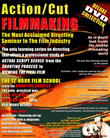|
|
FEATURES
- Independent Film Making
|
 |
|
|
|
|
|
|
|
|
| Sponsors |

|
|
|
 |
|
 |

|
|
Independent
Film Making Part II
|

|
According to Michael Wiese in his book The Independent Film and Videomakers Guide, there are five basic rules to keep costs down.
1. Question every price. It doesn't matter what the price tag says. There's always room for reductions. Always ask if the price could be lower. Somewhere, there is someone willing to do it cheaper and quite possibly better.
2. Shop around. Take the time to ask a lot of questions, make numerous phone calls, interview technicians, visit studios, etc. Check out every lead you can until you are an expert on people, places and prices.
3. Collect information. Often it's the information about a technical process or approach that you are paying for. Most information is free, but you have to be motivated to do some research. The more you learn, the more options you will have.
4. Give yourself time. Too often producers and production managers don't take the necessary time to research every aspect of their production. Careful planning will make for a smoother, more cost efficient production.
5. Plan ahead for the long haul. Spend as much time as you can in preproduction. The thought process that occurs in preproduction costs very little. When you are in production every day is extremely expensive. Have everything well thought out ahead of time so you aren't wasting time and money while people get paid to stand around. Successful low-budget filmmaking only works with great preproduction planning.
|
|

|

|
|
When people know what is expected of them, they perform their best. If they sense or see that the director doesn't know what he or she is doing, then they loose respect and enthusiasm for the
project
|
|

|
|
Every single decision you make on a film costs money. Therefore, if you examine every step you'll eliminate waste and create savings.
1. Prepare a detailed script. The cost of writing a detailed script is minimal compared to what it costs for being creative on a set. The more planning before the cameras roll the more you'll save.
2. Rehearse your actors. When it's time to go on the set it may only take a word or two to get your actors ready for the camera.
3. Communicate with your department heads. When people know what is expected of them, they perform their best. If they sense or see that the director doesn't know what he or she is doing, then they loose respect and enthusiasm for the project.
4. Don't spend money on unnecessary things. There's nothing wrong with setting up a "no budget" movie. People understand that. Either they want to work with you or they don't. If you are enthusiastic enough, you'll get your movie made.
5. Use buyouts when working on low-budget project. This means that you pay a flat daily rate regardless of how many hours are worked. This way, you'll know exactly how much the cast and crew will cost at the projects outset, and you will avoid overtime charges which can quickly send you over budget.
6. Options. The normal practice is to option rather than buy literary properties. If you can't get the project off the ground then losses are minimized.
7. Utilize Consultants. There are consultants for everything. You pay for their knowledge only when you need it. They are not on staff. A consultant can guide you away from costly mistakes. Consultants are people such as production managers, assistant directors, producer's rep, etc. The greatest weakness of a young filmmaker is that they are unwilling to admit they don't know something. 8. Reuse sets and get free locations.
|
|

|

|
|
To protect the film and its supporters from claims of copyright infringement that may result after the film is made, an E and O policy is normally drawn up by an attorney and carried by the picture... If you are in 16mm you will eventually have to go to 35mm for most theaters
|
|

|
|
Where do most filmmakers get into trouble?
1. Filmmakers do not get clearances from everyone involved. You absolutely must clear the rights to everything and everyone that appears in your movie. Without releases you will not get Errors and Omissions insurance (E and O policy). To protect the film and its supporters from claims of copyright infringement that may result after the film is made, an E and O policy is normally drawn up by an attorney and carried by the picture. In most cases, if a claim of infringement is brought forth, it can be successfully defended without ever going to trial. Without this policy, a distributor will not release your film.
2. Music is often overlooked until the last minute. Costs are underestimated. As previously stated, do not rely on certain pieces of music for your film, but have ideas in mind and make sure to figure this into your overall budget
3. Pay attention to the type of film you are using for your picture and realize the cost of changeover if you are to release it to theaters. If you shoot in 16mm you can strike an answer print and be shown in festivals. If you want to do a blowup from 16mm to 35mm you will spend around $40,000 to $50,000 dollars. If you are in 16mm you will eventually have to go to 35mm for most theaters.
|
|
|
|
|
|
|
|

|
|
|

|

|
|
top of page
|
Home
Page |
Contests
| Indies
| Features
| News
| Resource
Links
| Advertise
With Us |
Important
disclaimer
Copyright ©
1999-2011 by FilmMakers.com. All rights reserved.
FilmMakers.com
is a division of Media Pro Tech Inc.
|

|
|
|